Hitachi Deskstar 7K1000 in RAID 0: Is Two Terabytes really better than One?
by Gary Key on April 19, 2007 12:15 AM EST- Posted in
- Storage
Actual Application Performance
Our application benchmarks are designed to show application performance results with times being reported in seconds, with lower scores being better. While these tests will show some differences between the drives it is important to understand we are no longer measuring the pure performance of the hard drive but how well our platform performs with each individual drive. In that sense, these are the more real-world tests that show how hard drives and RAID 0 can impact your everyday computer use.
The performance of a hard drive is an integral part of the computer platform but other factors such as memory, CPU, core logic, and even chipset driver choices can play a major role in determining how well the hard drive performs in any given task. Also worth noting is that new features of Windows Vista - specifically SuperFetch - can further reduce the measured performance differences between hard drives.
Game Load Tests
In our Half-Life 2: Lost Coast test we measure the time it takes to load the game with the application timer starting when the play game icon is initiated in the Steam menu until the main game menu appears.
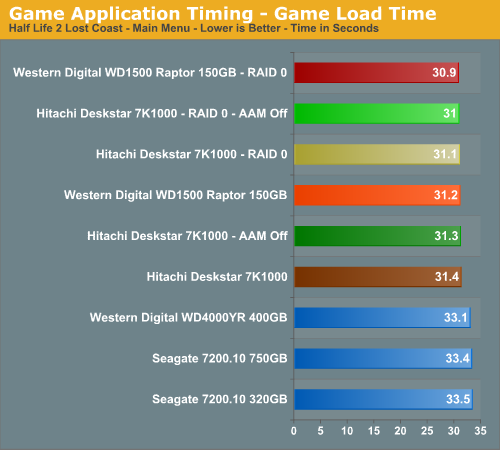
The results speak for themselves with the RAID 0 setups offering extremely minor performance improvements in actual game load testing. You will likely not be able to notice any differences during actual game play with a RAID 0 setup. We know it was impossible for us.
Our Sims 2 - Open for Business test measures the time it takes to load the initial portion of the game. Our application timer starts when the game icon is initiated until the neighborhood menu appears.

We witnessed 38% to 50% improvements in our iPeak tests in this game but measure less than a 2% difference in actual game load times. Without a benchmark, these differences are impossible to witness during actual game play. Once again, we see the Raptors slightly ahead but the 7K1000 for all intents and purposes is even in our game benchmarks.
Game Level Load
This test centers on the actual loading of a playable level within our game selections. We run Battlefield 2 and measure the time it takes to load the Daqing Oilfields level. Our application timer begins when the start single player icon is initiated and ends when the join game icon is visible.
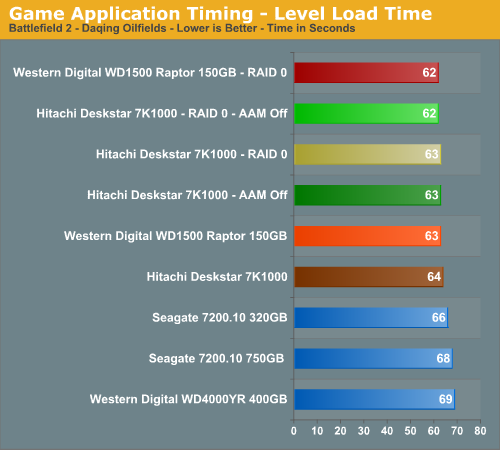
Once again we see a minimal difference between our RAID 0 and single drive configurations in this benchmark with only a one second difference in load times. In repeated testing it was difficult to discern any differences between the RAID 0 and single drive setups. On a side note, we firmly believe the areal density and 32 MB cache advantages of the Hitachi 7K1000 make up for the rotational and random access advantages of the Raptor in our gaming tests.
WinRAR 3.62
Our WinRAR test measures the time it takes to compress our test folder that contains 444 files, 10 folders, and 602MB of data. This is same test folder utilized in our iPeak test suite. This benchmark is extremely CPU/RAM intensive but it may require a fast storage system to keep pace.
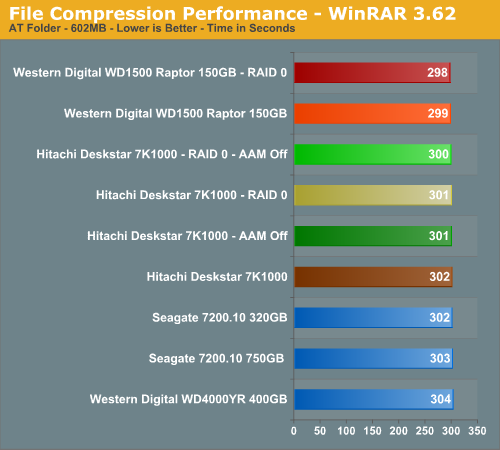
Our iPeak test showed a 50% advantage for the RAID 0 setups but we see an insignificant difference in the actual test results. One would assume the potential write speed advantages of a RAID 0 setup would have a larger impact on performance in this benchmark but in actuality CPU throughput makes a far more significant difference.
Nero Recode
Our encoding test is quite easy - we take our original Office Space DVD and use AnyDVD Ripper to copy the full DVD to the hard drive without compression, thus providing an almost exact duplicate of the DVD. We then fire up Nero Recode 2, select our Office Space copy on the hard drive, and perform a shrink operation to allow the entire movie along with extras to fit on a single 4.5GB DVD disc. We leave all options on their defaults except we turn off the advanced analysis option. The scores reported include the full encoding process and are represented in seconds, with lower numbers indicating better performance.
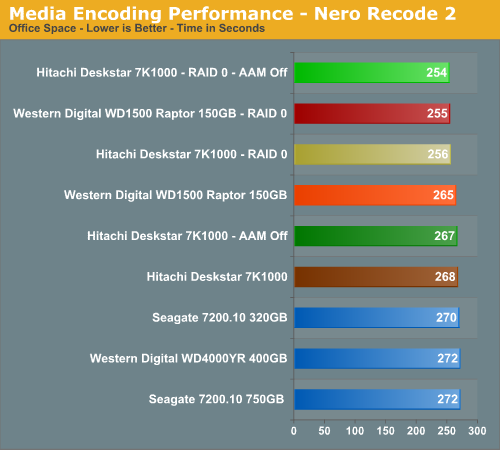
The iPeak results showed a 93% improvement with RAID 0 and we know from previous experience that RAID 0 can make a difference in this particular test. How large the difference would be was anybody's guess, but we figured it was the last chance for RAID 0 to generate any meaningful performance improvements. In the end, we did have measurable differences between the two setups with the RAID 0 configurations performing about 5% better. If you do a lot of video encoding then RAID 0 could end up saving you some precious minutes each day. Is it worth the cost or effort? Probably not, but it is one area besides benchmarking where RAID 0 actually made a difference. Of course, if you don't already have the fastest CPU for encoding available, that would have a far greater impact than RAID 0.
File Copy Performance
Our file copy test measures the time it takes to transfer our test folder that contains 29 files, 1 folder, and transfers 7.55GB of data from our source drive to the target test drive. This is same test folder utilized in our iPeak test suite. This benchmark is disk write intensive and requires a fast storage system.
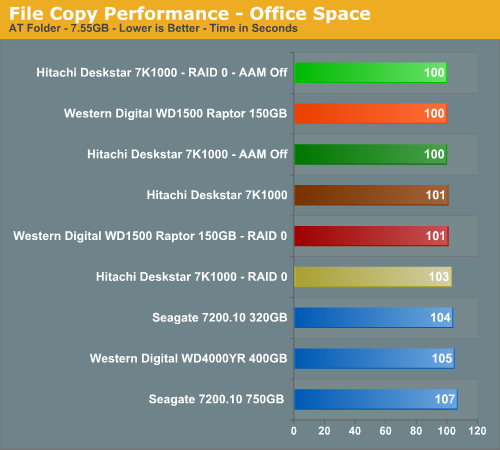
We finish our tests with a benchmark that should have favored the RAID 0 setups due to a pure write scenario. Unlike our iPeak test (and for that matter a similar test in PCMark05) where the largest differences in scores between setups were generated, we have RAID 0 making no difference in this test and actually scoring worse than a single drive setup in two instances.
Our application benchmarks are designed to show application performance results with times being reported in seconds, with lower scores being better. While these tests will show some differences between the drives it is important to understand we are no longer measuring the pure performance of the hard drive but how well our platform performs with each individual drive. In that sense, these are the more real-world tests that show how hard drives and RAID 0 can impact your everyday computer use.
The performance of a hard drive is an integral part of the computer platform but other factors such as memory, CPU, core logic, and even chipset driver choices can play a major role in determining how well the hard drive performs in any given task. Also worth noting is that new features of Windows Vista - specifically SuperFetch - can further reduce the measured performance differences between hard drives.
Game Load Tests
In our Half-Life 2: Lost Coast test we measure the time it takes to load the game with the application timer starting when the play game icon is initiated in the Steam menu until the main game menu appears.

The results speak for themselves with the RAID 0 setups offering extremely minor performance improvements in actual game load testing. You will likely not be able to notice any differences during actual game play with a RAID 0 setup. We know it was impossible for us.
Our Sims 2 - Open for Business test measures the time it takes to load the initial portion of the game. Our application timer starts when the game icon is initiated until the neighborhood menu appears.

We witnessed 38% to 50% improvements in our iPeak tests in this game but measure less than a 2% difference in actual game load times. Without a benchmark, these differences are impossible to witness during actual game play. Once again, we see the Raptors slightly ahead but the 7K1000 for all intents and purposes is even in our game benchmarks.
Game Level Load
This test centers on the actual loading of a playable level within our game selections. We run Battlefield 2 and measure the time it takes to load the Daqing Oilfields level. Our application timer begins when the start single player icon is initiated and ends when the join game icon is visible.

Once again we see a minimal difference between our RAID 0 and single drive configurations in this benchmark with only a one second difference in load times. In repeated testing it was difficult to discern any differences between the RAID 0 and single drive setups. On a side note, we firmly believe the areal density and 32 MB cache advantages of the Hitachi 7K1000 make up for the rotational and random access advantages of the Raptor in our gaming tests.
WinRAR 3.62
Our WinRAR test measures the time it takes to compress our test folder that contains 444 files, 10 folders, and 602MB of data. This is same test folder utilized in our iPeak test suite. This benchmark is extremely CPU/RAM intensive but it may require a fast storage system to keep pace.

Our iPeak test showed a 50% advantage for the RAID 0 setups but we see an insignificant difference in the actual test results. One would assume the potential write speed advantages of a RAID 0 setup would have a larger impact on performance in this benchmark but in actuality CPU throughput makes a far more significant difference.
Nero Recode
Our encoding test is quite easy - we take our original Office Space DVD and use AnyDVD Ripper to copy the full DVD to the hard drive without compression, thus providing an almost exact duplicate of the DVD. We then fire up Nero Recode 2, select our Office Space copy on the hard drive, and perform a shrink operation to allow the entire movie along with extras to fit on a single 4.5GB DVD disc. We leave all options on their defaults except we turn off the advanced analysis option. The scores reported include the full encoding process and are represented in seconds, with lower numbers indicating better performance.

The iPeak results showed a 93% improvement with RAID 0 and we know from previous experience that RAID 0 can make a difference in this particular test. How large the difference would be was anybody's guess, but we figured it was the last chance for RAID 0 to generate any meaningful performance improvements. In the end, we did have measurable differences between the two setups with the RAID 0 configurations performing about 5% better. If you do a lot of video encoding then RAID 0 could end up saving you some precious minutes each day. Is it worth the cost or effort? Probably not, but it is one area besides benchmarking where RAID 0 actually made a difference. Of course, if you don't already have the fastest CPU for encoding available, that would have a far greater impact than RAID 0.
File Copy Performance
Our file copy test measures the time it takes to transfer our test folder that contains 29 files, 1 folder, and transfers 7.55GB of data from our source drive to the target test drive. This is same test folder utilized in our iPeak test suite. This benchmark is disk write intensive and requires a fast storage system.

We finish our tests with a benchmark that should have favored the RAID 0 setups due to a pure write scenario. Unlike our iPeak test (and for that matter a similar test in PCMark05) where the largest differences in scores between setups were generated, we have RAID 0 making no difference in this test and actually scoring worse than a single drive setup in two instances.










48 Comments
View All Comments
photoguy99 - Thursday, April 19, 2007 - link
You have tested XP 32-bit which uses the "ScsiPort" storage system.This artificially limits results using Raid.
Vista 32, Vista x64, and XP x64 all use the "StorPort" storage system, which is much faster and doesn't limit Raid results.
You could add 4 or 8 drives in Raid 0 and your transfer rates would not change much.
This should really be part of the discussion for the article.
yyrkoon - Thursday, April 19, 2007 - link
Funny that, last time I personally did a dirrect comparrison of a 3xRAID0 array in Vista, it was 30-40MB/s slower comparred to the same array in XP Pro.Nothing changed, only the OS.
photoguy99 - Thursday, April 19, 2007 - link
Perhaps in your case the Vista driver was not as optimized as the XP driver or was not using storport.However, it is absolutely invalid to benchmark raid performance on XP 32-bit if your goal is to test hardware rather than OS specific results.
Microsoft reference:
http://msdn2.microsoft.com/en-us/library/ms803198....">http://msdn2.microsoft.com/en-us/library/ms803198....
AllanLim - Thursday, April 19, 2007 - link
http://kakaku.com/item/05300415786/">http://kakaku.com/item/05300415786/Along with every other pc component, this probably comes at 20-30% premium compared to Stateside when it becomes available, but at least you can but it here.
Myrandex - Thursday, April 19, 2007 - link
Two 250GB drives in Raid 0. I dunno, I still feel that it helps with some load times on large maps on games and large numbers of file transfers at once, but I could be full of it. I do keep an off disk backup though that is pretty current.Jason
Sunrise089 - Thursday, April 19, 2007 - link
Sorry to double-post, but the end of the article says:" As stated in both articles, we believe leaving AAM and NCQ turned provides the best user experience with this drive."
I think there should be an "on" or "off" after "turned".
Sunrise089 - Thursday, April 19, 2007 - link
I have a long-running arguement with another PC enthusiest about the relative merit of RAID 0. Some people just cannot get it through their heads that no matter how great the idea sounds, the performance just isn't justified by the cost. At all. With video card price/performance scaling perfectly, and CPU and memory scaling at least OK, it's insane to spend hundreds of dollars on a second hard drive and gain a few percentage points in real-world tests. Thanks Anandtech for keeping the real-world focus of these articles.mesyn191 - Saturday, April 21, 2007 - link
Depends how its done...These software RAID controllers (yes NVRAID, Intel Matrix RAID, Silicon Image 3112/4 etc, Promise, Highpoint are all software RAID controllers that often act more like storage subsystem DE-celerators and often slow things down...) that Anandtech keeps using to demonstrate the pointlessness of RAID 0 really only prove how crappy software RAID controllers are. If you use a "real" enterprise class RAID controller that has a dedicated CPU and significant cache you'll see some real world performance improvements, even with doing things like loading games which is a far from ideal work load for RAID 0. The problem is most of these "real" RAID controllers tend to cost ~$300, and that is for a cheap one, high end versions can easily cost thousands of dollars and most people don't want to spend that much on storage. Most of these enterprise class controllers also tend to have issues working with desktop motherboards, they're really meant for use in server motherboards and so they won't even boot up properly in alot of them, just read up on all the issues people tend to have getting the Areca 1210 (probably the most commonly used enterprise class RAID card in the enthusiast PC crowd) PCIe RAID cards working in commodity consumer grade motherboards.
Of course another nice thing about those enterprise class RAID controllers is most of them support multiple levels of RAID at the same time, so you can have a RAID 0 set and a RAID 5 set on the same bunch of hard drives, providing you a good way to safe guard your data and get a performance benefit.
PenGun - Friday, April 20, 2007 - link
K .... maybe you can tell me how I'm gonna get a solid write of 150MB/sec any other way. My camera in HD SDI needs to move that much data.RAID 0 or perhaps RAID 5 (to be tested soon) is the only way. 4 Western Digital 500G drives is my way of handling that fire hose of data.
Oh go back to your games it really does not matter, it's just my problem right now. It is my desktop when it's full. It's easier to crunch the massive files in situ.
yyrkoon - Thursday, April 19, 2007 - link
Some people just can not seem to get it through their heads, that not everyone plays games, or surfs the web, on a home desktop PC. Video editing applications that require 65MB/s substained transfers rates, will require either a very fast disk, or two lesser drives striped.
Since most enterprise drives cost an arm and a leg, I think running RAID0 for this application, or something that NEEDS the throughput justifies the cost. Now, I personally DO run RAID0 on my home desktop, and I think it is more than justified, but I do not expect it to work wonders, and I definately know, it will not make my system boot faster, will not make a First Person Shooter faster (except, perhaps level load times, which is pretty much moot).
Now, Imagine spending 2x $400 for RAID1 . . . that is what I call a waste of money, although, with these hitachi drives, who knows how reliable they are. The point here, being, you can not tell anyone what they need, or want in a desktop, because you really have not a clue what they really need / want. This being said, RAID0 for most people probably is overkill.